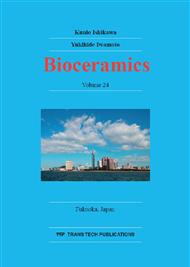p.357
p.361
p.365
p.370
p.374
p.379
p.385
p.391
p.397
Influence of Micro-/Nano-Particles on Osteoblast-Like Cells: A Static and Time Lapse Observation
Abstract:
Cytotoxicity and cell behavior to micro / nanoparticles of TiO2 and CuO was evaluated using the viability measurement and time-lapse observation. After cultured, osteoblastic cells MC3T3-E1 were exposed to particles. After 24 hour exposure, their morphology was observed using a SEM and the viability was measured. Cells exposed to TiO2 indicated no or very low decrease of viability. The results were independent of the particle size. On the other hand, the viability of cells exposed to CuO decreased with the concentration, and showed the size dependence. The nanosized CuO indicated higher toxicity compared with micro-sized one. Dynamic behavior of cells exposed to nanoparticles, was succeeded to observe in a time-lapse method for 24 hours. The observation showed that the cells exposed to CuO became dead after forming a spherical shape. This is consistent with the image taken by SEM. Time-lapse observation made it possible to see the dynamic reaction process from cell contact to particles at first, the following cell activity response and finally to cell death, which revealed a considerably different morphology from the static cell observed after fixation by conventional method.
Info:
Periodical:
Pages:
374-378
Citation:
Online since:
November 2012
Authors:
Keywords:
Price:
Сopyright:
© 2013 Trans Tech Publications Ltd. All Rights Reserved
Share:
Citation:


